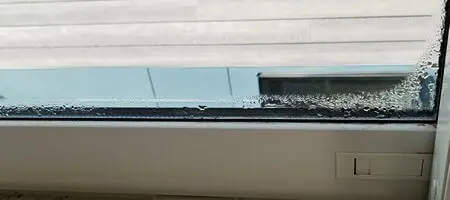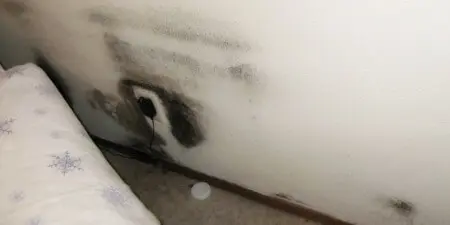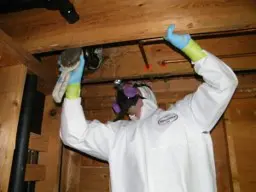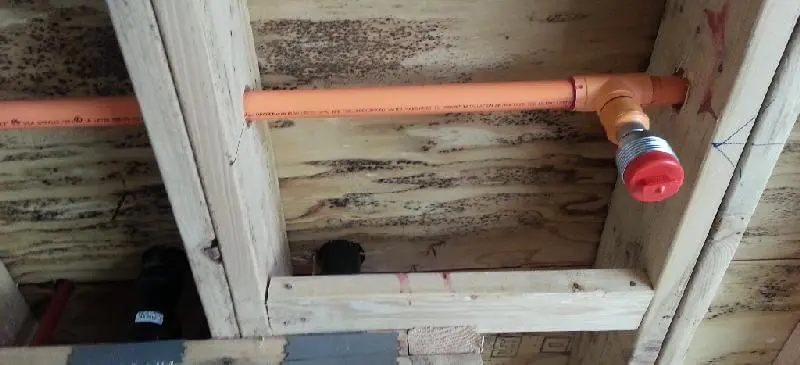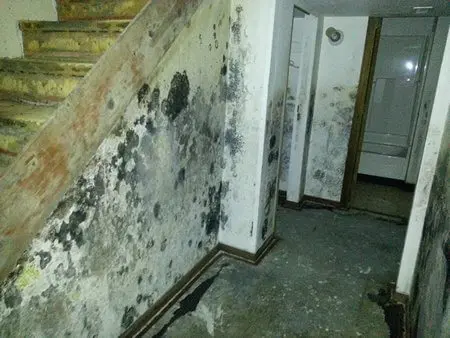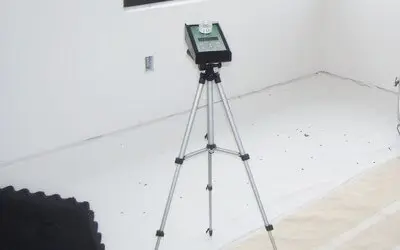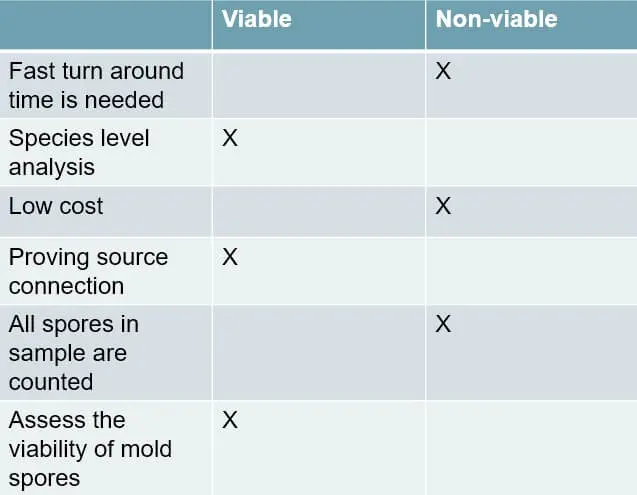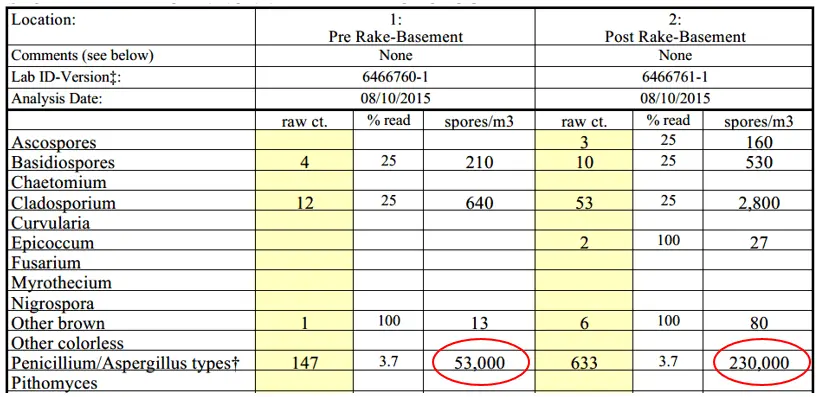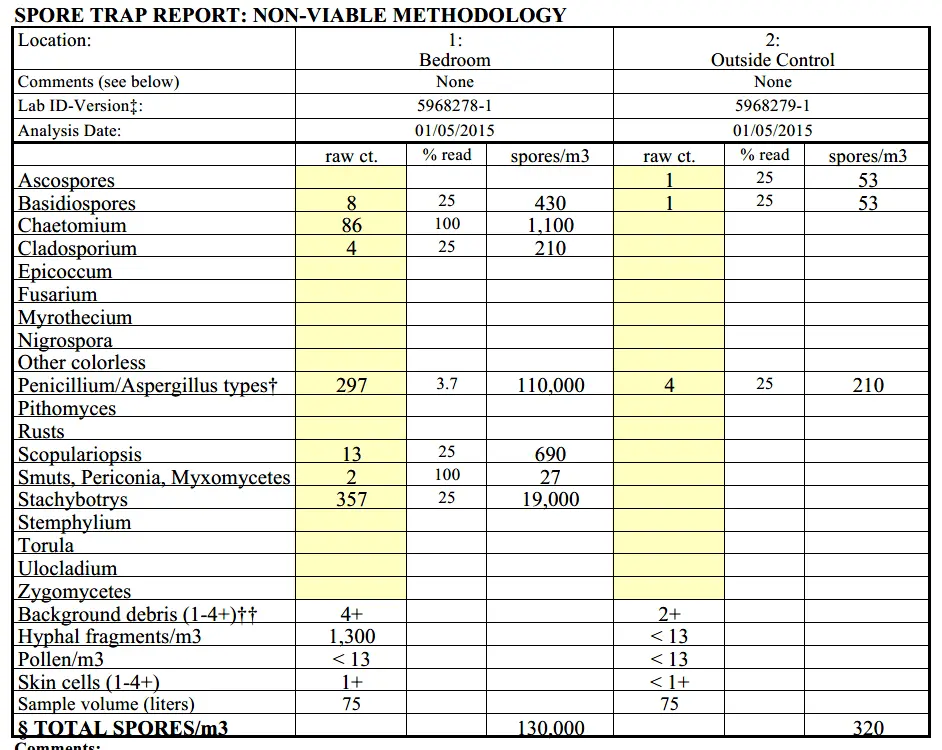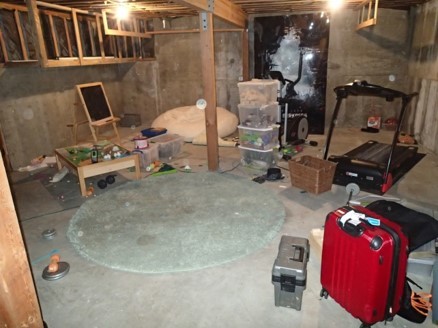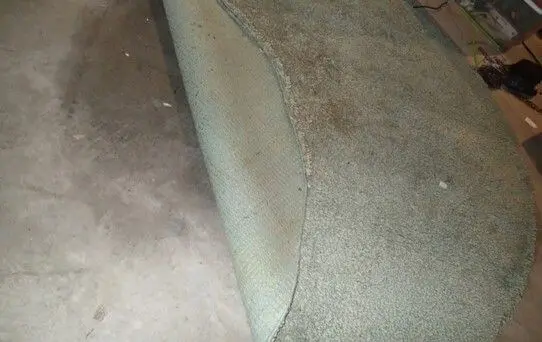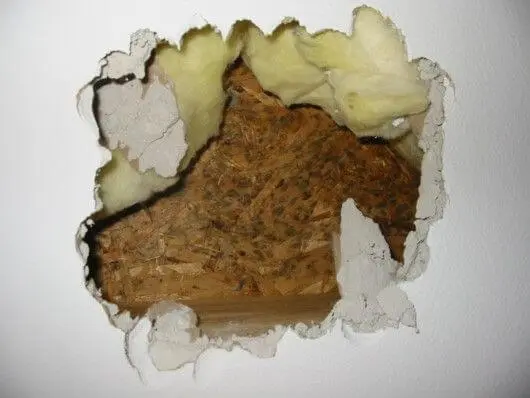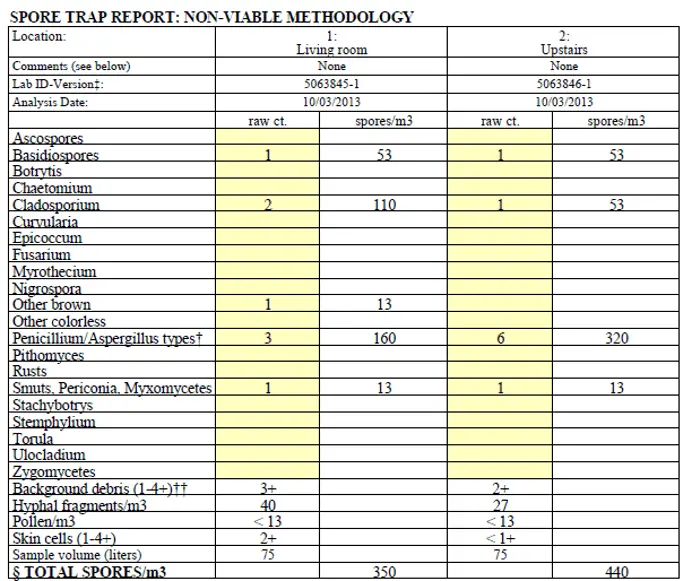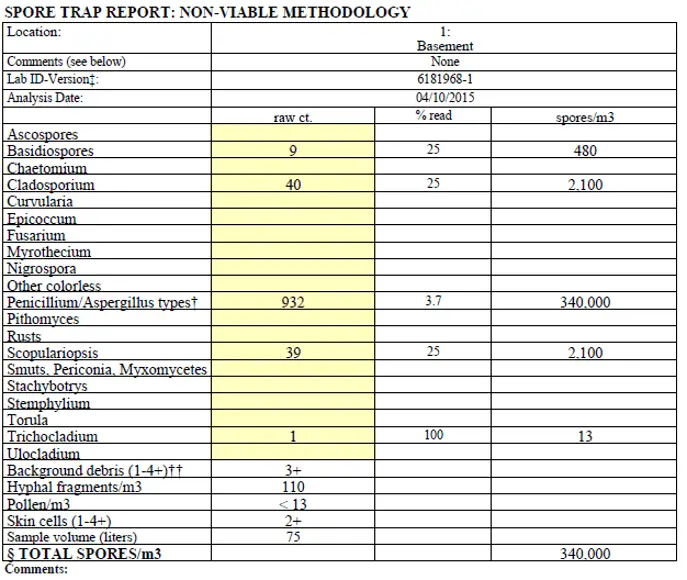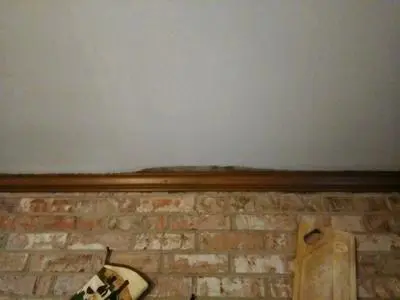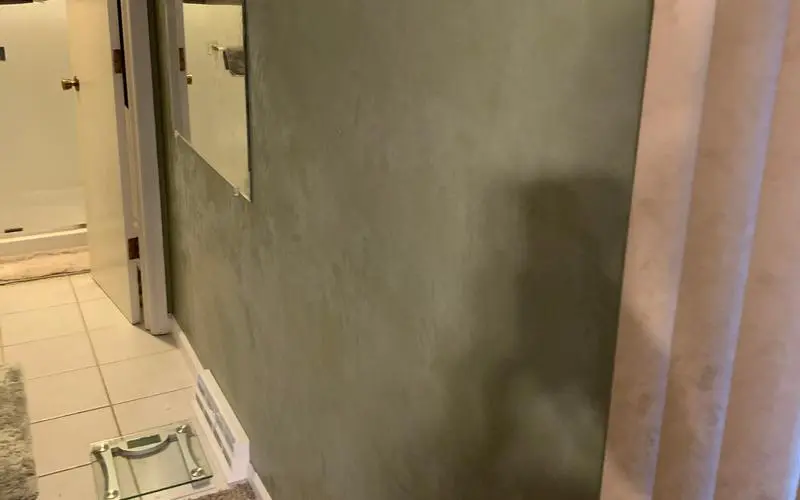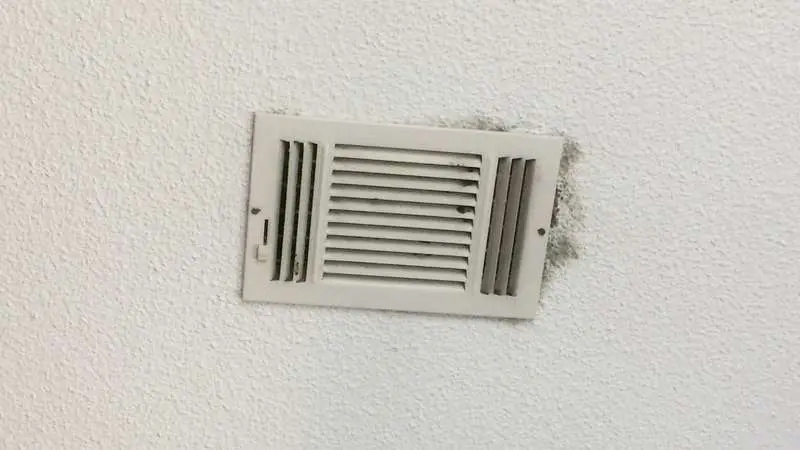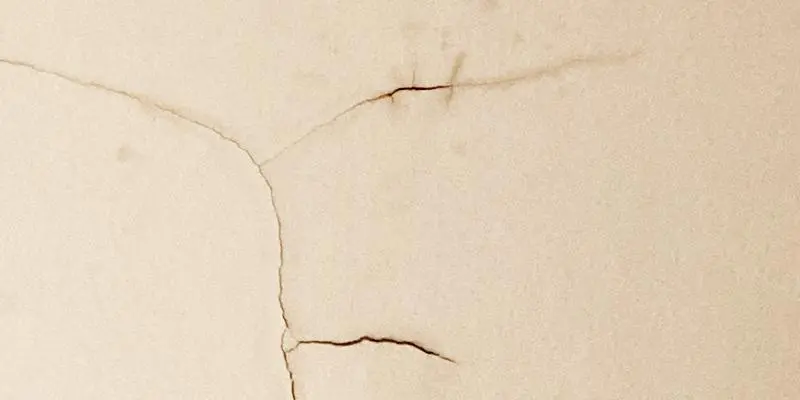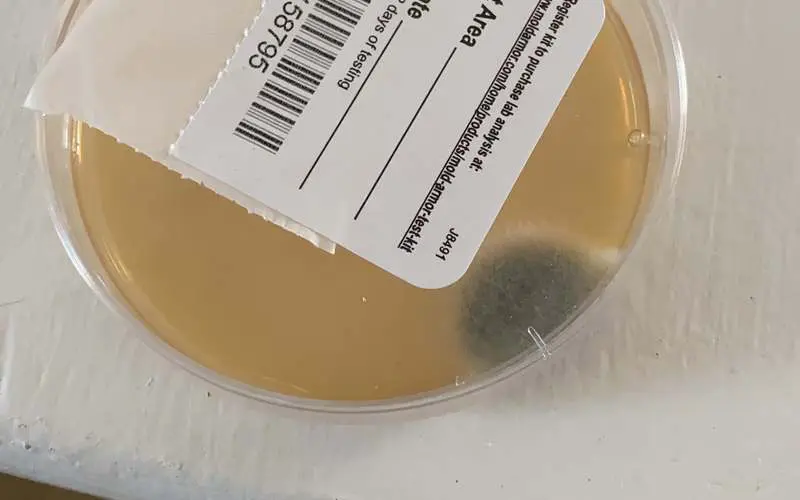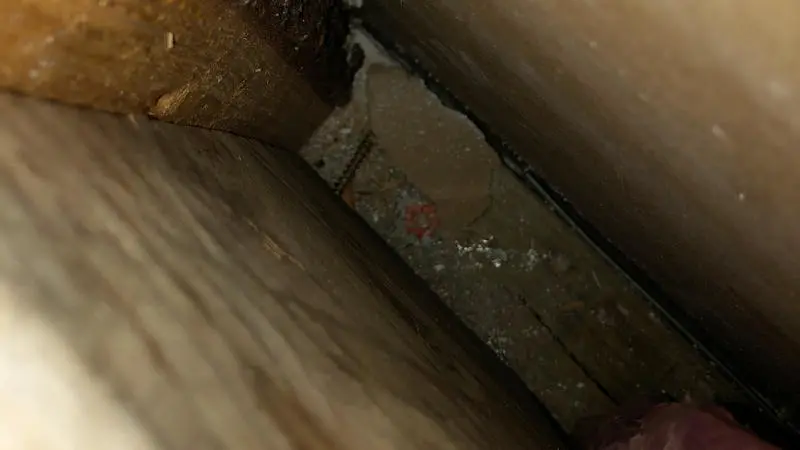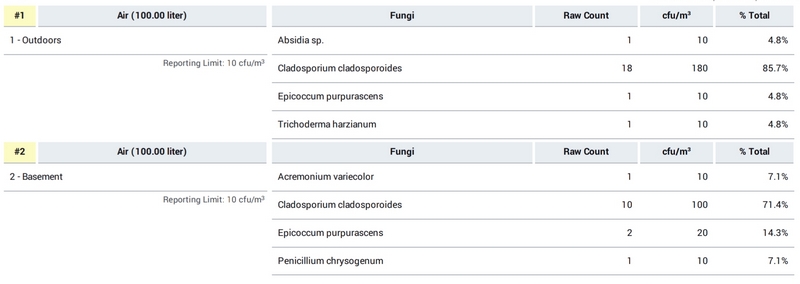TESTING FOR MOLD - SCAM OR SCIENCE?
Let’s start with a quiz. Which house has a higher mold spore count?
The room on the left is a bathroom with significant mold growth on the walls and ceilings. This was due to the lack of a bathroom fan. The photo on the right is a basement with no visible mold growth, but a damp rug and a strong musty odor. Mold testing was performed in both areas.

The results from mold testing?

Why such weird results?
Despite the heavy staining from the mold growth in the bathroom (left), the flat growth profile did not lead to substantial spreading of spores. The high spore count in the basement (right) was due to moisture trapped in the rug. Despite the fact the area rug was only 6′ across, the constant exposure to vapor emissions from the concrete slab led to a tremendous amount of mold growth. Amazingly, very little mold growth was visible. This is common with carpeting, as the mold grows within the pad and carpet fibers without much visual evidence. These are both good examples of when mold testing is helpful.
When should you test your house for mold?
Before any sampling is conducted, you must first identify the potential results. This may sound obvious, but many inspection companies charge thousands of dollars for sampling without ever identifying a real benefit. They may provide their clients with pages and pages of data, but no actionable information. Before any sampling is collected, you must first identify potential actions you’ll take based on the results.
1. You don’t see visible mold, but you have high humidity
If your home suffers from condensation on the windows, this is often an indication of poor air flow and high humidity. High humidity is one of the main causes of mold growth. In these scenarios, it is reasonable to suspect that mold growth may be occurring in the home and therefore, testing is a worthwhile option. This is especially true if you see condensation on a modern, double pane window.
2. You’ve found visible mold growth, but it’s unclear what materials have been affected
Let’s say you own a condo and you find mold growth on an exterior wall behind a bed. Your inspector concludes that the mold growth is due to condensation from a poorly insulated wall. The extent of the actual growth is obvious, but the extent of the settled mold spores is not. During mold growth’s cycle, thousands, even millions of spores can be released into the air.
The challenge is that the number of released spores can vary dramatically from one project to the next. Therefore, you cannot look at a site of visible mold growth and readily determine how many spores have been released. This means that you also cannot determine what other materials may have been affected.
In these situations, an airborne mold test can be extremely helpful in determining the spread of those mold spores. In the case of the mold growth behind the bed, the air sample will tell you if the carpeting, bedding, and other materials have been affected by the mold growth.
3. Your family suffers from health problems commonly related to mold exposure
Mold is a common trigger for individuals with allergies and asthma. If your symptoms seem to worsen at home, mold testing can be an effective way to determine if mold spores are the culprit. A similar connection is found with sinus infections. The EPA has excellent resources here. You can also learn more here.
4. You smell musty odors
Musty odors are often, but not always, associated with mold growth. Because of this fact, air sampling is a great technique for verifying if elevated mold spore counts are truly present. Mold growth releases odors during certain portions of its life cycle. This release of odors is based on a variety of complex factors and is not a reliable indicator of active growth. For example, you may have a building with a strong musty odor and very little active mold growth. The EPA discusses it here.
Alternatively, you will often encounter projects with no odors at all, that in fact have very high mold spore counts. The only way to accurately determine the presence of mold spores in these cases is to collect an air mold sample.
5. Remediation has been performed and you need proof it’s clean
Airborne mold testing is commonly used for both internal and 3rd party clearance testing. When a mold remediation project is completed, air testing is performed to verify that the mold spore counts have been reduced to normal levels.
When is mold testing not appropriate?
Areas outside the conditioned air space.
Airborne mold testing doesn’t make much sense for crawlspaces and attics. Those areas are directly linked to the outside air and therefore not a controlled environment. If the test results come back high, it may simply be due to the outside environment. Additionally, in the unconditioned areas, your primary concern is the building structure, not the air quality.
Because you do not breathe the air in the attic or crawlspace, an air quality test in these areas is of little value. In a crawlspace this is complicated even further by the natural mold growth that occurs on the damp soil. Because of these factors, in attics and crawlspaces, a tape lift sample or visual observations is superior.
Open jobsite
Similar to an unconditioned space, if a project is open to the outside air, it is not a good candidate for air testing. This is often the case during new construction. This can also occur during a renovation. For example, if the side of a house was removed for a remodel project, any testing collected inside the home would be of limited value. To accurately test the air, a temporary wall must be constructed first. Due to cost of building a temporary wall, it is often better to focus on visual observations and skip the air testing.
Obvious & extreme levels of mold
In cases where the mold growth is severe, mold testing often provides little value. For example, if the entire interior of a home requires demolition, air sampling will not provide any additional value. A simple visual observation will indicate to us that all surface materials will require removal, regardless of the findings of air sampling.
Types of mold testing
- Air sampling
- Direct sampling
- Bulk sampling
Within each of these categories, there are two primary types of results provided by the sampling. These are ‘quantitative’ and ‘qualitative’. Quantitative sampling attempts to measure the quantity of mold spores in a given area.
The most common type of quantitative sampling is non-viable air sampling. The results of this sampling are provided in a numerical format and compared against averages. This provides the client with a sense of the severity of the mold problem.
Qualitative sampling is much simpler. It seeks to verify if mold is present. This type of sampling is less common, because mold growth can typically be verified visually, without laboratory sampling. Qualitative sampling is useful when mold growth may be confused with similar looking substances, such as efflorescence. A tape lift sample or bulk sample is the preferred method.
Air sampling – this is where it gets tricky
Air sampling is the most common lab test used in indoor environmental evaluations. There is a good reason for this. Air sampling is the most accurate method for determining exposure. While a tape lift may accurately determine if mold growth is present on a particular surface, it will not tell you whether that mold growth has actually affected the indoor air quality. Only an air sample can accomplish this.
As we discussed earlier, the primary exposure route for mold growth is through inhalation. Therefore, testing the air for elevated levels of mold spores is the most accurate way to determine if the occupants are exposed to excess mold.
There are 2 main types of air samples. Non-viable and viable image. Both samples operate by running air through an impactor device. The air is drawn into the device and impacted on a sticky substance. The air hits the surfaces and flows around the sides while the mold spores stick to the surface.
Viable mold testing
Viable samplers, such as the Anderson Impactor, impact the spores on a petri dish. The petri dish contains a food source for the mold growth. Over time the mold grows, allowing the laboratory to identify the type of mold.
Non-viable mold testing
Non-viable testing is typically performed with a slit impaction sampler. A popular example is the Zefon Air-O-Cell cassette. These are small plastic cassettes with a narrow opening and a sticky surface inside. The mold spores are drawn through the slit and impact the sticky surface. After the samples are collected, the lab opens the cassette and reviews the slid surface with a microscope. The laboratory can identify the number of spores and the genus, but not the species.
Comparison of airborne mold testing techniques
Viable or culturable samples have a lengthy analysis time, often 10-14 days. This is the amount of time required for the mold spores to begin to grow. Non-viable samples can be processed immediately, even the same day if necessary.
Viable samples can provide a species level analysis. This can be important when attempting to draw a correlation between mold growing in a particular area and elevated mold spores in the air. While a non-viable sample can provide a likely correlation, only a viable sample can prove the connection. For this reason, when there’s a chance a sample will be used in a court case, a viable sample is recommended.

Notice how Penicillium and Aspergillus are grouped together
Viable samples are important when testing areas with severely immunocompromised patients. These people are susceptible to infections from mold. And because only viable spores can cause infections, testing for viability is critical.
One major drawback of viable sampling is the limited number of mold spores that can be measured. Only spores capable of reproducing will be measured. With non-viable testing, all spores are counted. Non-viable spores may still be able to produce allergies, and therefore a viable sample may miss a critical mold exposure problem.
Due to the processing time required for viable sampling, the cost is much higher, often 4-6 times as expensive. In most situations, the fast turn around time and lower cost of the non-viable sample makes it the best choice.
Cost of mold testing
The cost of a mold inspection / test typically comes down to two parts – a call out fee and a per-sample fee. If the sampling is part of a comprehensive inspection (which is nearly always preferred), then the call-out fee is embedded in the inspection cost.
Most companies charge a base inspection fee of $175-350, plus a per sample fee of $95-145. The main variable in the pricing is not the per unit cost but the number of samples they recommend. This is where pricing can get out of hand quickly. In general, one sample per floor or per 1,000 sq ft is sufficient. Some companies greatly exceed this guideline and will gladly sell you on the importance of a dozen samples for your 800 square foot apartment.
This pricing is for non-viable air samples. Specialty samples like cultured/viable samples will cost considerably more.
As you’ll read below, sampling is not an absolute science. It should be regarded as a possible indicator of an issue requiring further investigation, not indisputable evidence of contamination.
Interpreting mold testing laboratory results
You’ve got the data, now what? This is where the frustrations begin.
Here’s a typical mold testing scenario:
A homeowner hires an inspector to sample their house for mold. They receive the results and are told everything is fine, the mold spore counts are well within the expected range. But they’re a little unsure of the result, so they hire another firm to get a second opinion. This inspector collects more mold samples, using the exact same techniques. After a couple days the homeowner receives the results. The spore counts are very similar, but the second inspector tells them to evacuate immediately – their home is full of dangerous levels of mold.
Who’s right? Why the wild discrepancy?
The problem is due to a lack of understanding of how to interpret the results of mold testing. Unfortunately, there are no agreed upon standards for interpreting this type of sampling. The EPA doesn’t have a guideline, nor does any other federal agency. Other guidelines exist, but they vary tremendously in their conclusions.
Why interpreting mold testing data is so difficult
The challenges related to mold testing are frustrating, but understandable. Mold spores are ubiquitous. Unless you’re in a hermetically sealed clean room, there are hundreds or thousands of mold spores floating in the air. This isn’t the main challenge though. Mold testing can easily count the number of spores in a given quantity of air.
The problem is the lack of uniformity. Let’s say you collect a sample, then run another one an hour later. It would not be surprising at all to see a 100% increase in the number of spores.
Did the room suddenly become infested with mold? No. Perhaps the wind shifted slightly outside. Perhaps spores were pulled into the room when the door was opened. Merely walking on a carpeted surface can stir up hundreds of spores.
This leads us to our first rule:
Mold testing can only evaluate large increases (or decreases) from the baseline
A 10%, 15% even 20% increase or decrease over the control is statistically meaningless. We’re looking for large changes – typically an order of magnitude. Technically you can derive meaningful conclusions from small changes. However, to achieve this you have to collect a large number of samples. In most cases this is impractical and cost prohibitive.
In general there are 3 approaches, the Inside Comparison Method, the Outside Comparison Method and the Fixed Standard method.
Inside comparison method
The inside comparison method of mold testing collects a sample in an unaffected portion of the home. This technique is useful if the entire home is relatively dirty and unkempt. In some cases, the entire house may have elevated levels of mold spores because of humidity problems unrelated to the area you’re testing. This must be identified in the beginning or the remediation contractor may have a hard time passing a clearance test.
If this pre-sample isn’t collected, the remediation project might fail, simply because the mold spores from the rest of the home is contaminating the containment zone.
The outside comparison method
This technique follows the same principle, but instead of collecting the comparison sample from an adjacent area of the home, the sample is collected from the outside. This method is widely used and works well in most circumstances. However, keep in mind, if it has recently snowed, the outside control sample may be extremely low. In these cases, even the smallest number of mold spores would cause a failure. A Fixed Standard approach would works better in these situations.
Fixed standard method
Instead of comparing the mold spores in the containment to the remainder of the home, the mold spore counts are compared to a pre-determined level of acceptable mold spores. For example, some standards apply this method by creating a threshold for specific types of mold. I.e the spore counts for penicillium/aspergillus, stachybotrys and chaetomium cannot individually exceed 500, and the total of all spores must remain below 2,000.
individual types of mold spores 500 spores per cubic meter as the cutoff. Others reference the total number of mold spores, regardless of the type.
Often the best approach is to combine several standards. For example, if any of the following conditions are met, the mold spore levels are considered elevated: 1.) The total spore counts level of all species exceeds 1,500 spores per cubic meter or 2.) Any indicator species, such as Stachybotrys or Chaetomium is greater than 300 spores per cubic meter.
Putting it all together with real world examples
Let’s compare two real projects and with unusual sampling results. The first project involved a basement with a strong musty odor. The odor was limited to just the basement storage area. Numerous items were stores in the basement but no visible mold growth was observed. The client also did not recall any recent flooding events or moisture problems in the basement.
During the inspection, a small area rug was moved, exposing an area of discolored concrete. Based on this observations, moisture meter readings were taken from the rug, which revealed high amounts of moisture. The rug was also wet to the touch. After removing the rug, the concrete was tested using the comparison technique. This confirmed the initial hypothesis. The discolored area of concrete was in fact wet. Based on these results, what would you expect to find in an air test?
Before we answer that question, let’s look at another scenario:
A client was attempting to install built in book shelves and after removing a piece of sheet rock found mold growth on the exterior sheathing. The client subsequently removed other areas of sheet rock and found mold growth in many other exterior walls . Throughout the entire home, mold growth was found on the sheathing. Moisture meter testing indicated dry conditions throughout and it was determined that the mold growth was due to rain water saturation during the original construction of the home.
Air quality testing was performed to determine if elevated levels of mold spores were present. When comparing this scenario to the basement we looked at earlier with the small area rug, which do you think would have the higher mold spore count?
Let’s look at the data
The first set of data is from the house with mold inside the walls. You’d expect a house with mold throughout all the walls to result in compromised indoor air quality, right? Look at the data. The house is quite clean. The mold spore counts are in line with a clean, well-kept home. Why? The mold growth was several years old. Because it was not actively propagating, the mold spores were unlikely to spread. Second, because the mold growth had occurred inside the wall cavities (behind the sheetrock), the spores were relatively well sealed from the indoor air.
Now let’s look at the data for the basement with the wet rug. 340,000 spores per cubic meter for Penicillium/Aspergillus. This is an extremely high spore count, close to 1,000 times greater than a typical outside sample.
This tells us a couple of important pieces of information. First, the quantity of mold growth in a home is less important than the location of the mold growth. Even though the second home we examined had mold covering hundreds of square feet, those mold spores were trapped within the walls and had no one of affecting the indoor air quality. In the other example, even though the mold growth was limited to a small area rug, those spores were easily disturbed and therefore, readily distributed into the air.
*Heads up – I earn a small commission on sales through Amazon links. This helps cover the expense of running the website (and answering your questions!)
Got a question? Ask it here and we'll post the answer below
I have a total spore count of 2,520 and I'm told I need to remediate now. Then I have O.S. Baseline total spores is 3,486 (not sure what O.S. baseline means).
I recommend holding off on remediation until you have more information. The total spore count is of limited value. You need to know the spore counts of individual types of mold spores. This is because some spores (i.e. Basidiospores) are commonly found in very high levels in the outside air.
For example, the 80th percentile for December in Washington is 5,000. This means 20% of the time, Basidiospores are found at levels over 5,000 in the normal outside air. If your indoor sample consisted mostly of this type of mold, it would not indicate a mold problem. It simply means the mold spores floated in through the door. This is why indoor mold spore counts should always be compared to outside averages.
In general, extensive remediation is not recommended unless the indoor counts are multiple times higher than the outside figures (or you see visual damage).
I had a mold test done in 2 areas of my house (master bathroom and guest bedroom). They came back positive for mold in these areas. After remediation they only tested the living room which was not affected at all, not the original 2 rooms. Why would they test an that wasn't affected instead where they remediated?
Good question. In most scenarios, a clearance sample is collected within the containment/ remediation zone. This is to prove the mold spore counts have returned to normal levels. Occasionally an additional sample is collected from outside the remediation zone to check for cross contamination. I can’t think of a scenario where one would only collect a sample from the adjacent rooms and not within original remediation zone.
Last July I was told that I should move out of my home right away because of dangerous mold. Since then the insurance company has refused to pay for remediation and I have been paying rent and wondering how I will be able to save money to get back into my home. I have been wondering lately if I reacted too rashly and wonder if they were just hoping I would pay for remediation. I live inland in SW Florida. What do you think about all of this?
The mold testing report indicates the outside air had a higher mold spore count than the air inside your home. This is a good sign and certainly is no cause for vacating the property, unless there was substantial visible mold growth. We see this situation quite often. The industry is full of unscrupulous (or simply uninformed) inspectors who stoke fears by misinterpreting results.
I had a company come in to look at what I think is black mold. The rep had some sort of hand held gadget that sticks in the wall. He said any reading over 10 is a concern. He had readings as high as 25. I do have water coming into my basement. I do have black spots on my wood trim and along the baseboard. What is your opinion?
It’s difficult to say without seeing the actual piece of equipment. If it was a moisture meter, they work on either a relative or absolute scale. If it’s an absolute scale meter (measures the true moisture content), the cutoff of concern is around 18-20%. Anything above this should be investigated further. Below this is normal.
Relative scale moisture meters work on either a 0-100 or 0-200 scale. Of the models I’ve used, none would indicate a water problem until above 20.
Note, these only read moisture content. There are no devices on the market that can count the number of mold spores on a surface. All mold sampling requires lab analysis.
The fact you have water entering the basement and visible mold is cause for concern. I’d hire a reputable basement waterproofing contractor to evaluate the source of the leak.
I've just noticed this stain on my kitchen ceiling, What could this be?
This looks like mold growth. A tape lift sample would definitely confirm if this is the case. The cause is either a flashing failure at the roof/chimney junction or condensation from a lack of air sealing and insulation. Based on the photo – it looks more like a roof leak.
The Pen/Asp-like structures came up as over 3,000 in my basement and first floor and the mold remediation company said thats high. Is that high? Do i need formal remediation?
Yes, in most regions this is considered moderately elevated. Keep in mind, it is possible to have far higher results. For example, it is not uncommon to see problem homes with 10,000+ spores.
As with any mold issue, it’s imperative to first identify the source of the elevated spores. For example, was the sample collected in a carpeted area? If so, is the carpet on a concrete slab? Is the carpet old? Does the home suffer from elevated humidity or have a recent water leak. These questions are critical to answer. Otherwise, it’s quite easy to spend quite a bit of money on remediation that fails to address the underlying problem.
We are renting a house in Iowa where it gets very hot and humid. A few weeks ago, our air conditioner went out and it took the landlord 2 weeks to get it fixed and a new furnace installed. Since the summer, we have noticed a white, somewhat powdery substance coming through the paint on the walls in our bedroom and hallway. I have been ill for the last 5 months with unexplained symptoms that can be explained by mold exposure, but we have not yet told the doctors because we are not sure it is mold we are dealing with. We had an inspector come out 3 days ago and do an air quality sample. He did the outside in the front of our house and the outside in the back of our house, then took a sample from the hallway. When he saw the substance on the walls, he felt sure the inspection results would show that there were high levels of mold in the air however when the sample came back, it came back with a non-elevated status. When we asked him about the results, he said he did not have any explanation as to what happened with the results. We moved out of the house for 5 days and my symptoms improved greatly but since the air inspection said the home was fine, we were forced to move back in because we cannot afford to move permanently. We are having another inspector come out today for another test. If this is not mold on our walls, why is it getting worse when it is hot and humid and why does it keep coming back after we wash the walls? The areas of the walls affected but the white powder feel damp and sticky to the touch.
I recommend collecting a tape lift sample of the suspicious substance. This will definitively tell you whether the substance is mold. The lack of mold in the air test is unusual, but not unheard of. Occasionally, mold growth occurs without releasing substantial quantities of mold spores into the air. In these cases, a tape lift sample is needed to determine the nature of the substance.
If the results indicate it is not mold, it is likely related to the paint itself. A dramatic change in humidity could cause surface deposits as the vapor pulls minerals to the surface. This problem should resolve itself after the humidity drops. Has the powder returned after the A/C was fixed?
Hello, I live in a condo building and have just noticed above my bathroom tub on the ceiling a black spot with ring around it and a couple of very light green/black spots. There is also a long white fuzzy line that appeared on the ceiling but not in the pic. There are also two yellowish spots. These are all near the access panel to the piping for the unit above. The last time the unit above leaked through the access panel was in 2012. Not sure if these spots are due to condensation buildup or other. Do I need to get mold testing by a mold testing company or can I clean it myself? Thank you!
The best way to differentiate between condensation and a water leak is with a moisture meter. The amount of moisture left by condensation will typically not register as elevated with a moisture meter. If it’s a leak from above, it will definitely show up on the meter.
If the spotting is light and sporadic, it’s likely due to condensation. Condensation can cause heavy growth in a bathroom, but it won’t form in a localized area like a leak would cause. Does the bathroom have an exhaust fan? If so, I recommend running it for at least an hour after every shower/bath.
If the mold growth is limited to the bathroom ceiling (and you verify it’s from condensation), you can clean this without professional assistance. Use a detergent / water solution and gently scrub the mold growth. Some staining will likely remain, but this is simply lingering pigment and not a health or regrowth issue.
If repainting your ceiling, use a high quality exterior grade paint. This will offer a greater resistance to mold growth than your standard indoor paint. Also, the more matte the paint, the more conducive to mold growth.
Hi, the outdoor Basidiospores ct/m3 is 1157, yet the indoor is 10258? Is that a problem? The total spores/m3 indoors is 13677 and outdoors is 1788.
Basidiospores are distinct from other types of spores found in IAQ tests. In most cases, they come from the outside air (via windows and doors). If they are truly growing in your home, it is likely due to mushrooms or wood rot. I recommend examining the crawl space or any other areas where rot or mushrooms could be growing. If everything is clean, it was likely due to spores floating in from the outside. In this case, no further action is necessary. Here is a link for more info about basidiospores.
I am being told I have really dangerous mold in my home and that it would normally cost between 9 and 15 thousand dollars for remediation. there is no visible mold anywhere or leaks. I am a disabled mom of two. I don’t have that money. Are we going to die??
The type of mold growth found in your home is very common. While the level is elevated, you are certainly not going to die. A walk in a wet forest would likely expose you to far greater amounts of mold spores.
The most important task is to identify the underlying cause of the mold. All mold growth requires excess moisture to propagate. If there is no visible mold growth, it’s likely due to elevated humidity. This can be fixed by adjusting your ventilation or HVAC equipment (depending on where you live). If you live in a climate with winter humidity issues, increase your ventilation by running your bathroom fan.
If you live in a hot/humid climate, you’ll likely need to utilize your air conditioner to lower the humidity. A dehumidifier may also be necessary. I would not recommend spending $9,000+ to remediate the issue. Spend the majority of your money on fixing the underlying issue.
Mold appears around HVAC events. What should I do?
I assume this home has air conditioning? If so, this is due to condensation forming on the cold ducting in the attic, then dripping onto the adjacent sheetrock. Check the insulation around the ducting and register.
This could also be due to an oversized air conditioner, which causes the unit to power off before it’s sufficiently pulled the humidity from the air.
hen the cold air exiting the ducting lowers the temperature of the surrounding sheet rock. If the humidity in the home is high, this will cause condensation and mold growth.
Would this water damage over 2 years from a leaking balcony cause mold? It looks like there could be on the ceiling.
Yes, it’s possible mold growth occurred during the original leak. However, the growth would have stopped as soon as the ceiling material dried out. The mold from the original growth period will remain indefinitely, but it is not active or spreading. The ceiling is acting as an air barrier between the cavity above and the indoor air. Any lingering mold spores are trapped in the ceiling cavity and cannot enter the interior air within the home.
I used a mold test kit from Lowe’s and I did everything that I was asked to do to test the area. I tested my vent and about 5 days later I got a small pop up of some kind of mold. Now it’s getting bigger every single day and there is actually another type of mold that is growing inside the kit as well which I believe is white mold. My landlord said that it’s not his responsibility for doing that testing and I’m trying to get results immediately because I believe my health problems have been because of mold.
You might have a mold issue, but these types of test kits provide very limited reliability. They are not used by professionals for this very reason. I’ve got an in-depth explanation on this page (the page is not finished, but the content related to theses test kits is complete). I highly recommend a non-viable air pump based sample, such as the Air-o-Cell cassette. This type of sampling provides quantifiable and comparable data.
There is a musty/moldy smell coming from our closet. There are no visible signs of mold on walls, carpet or ceiling. I have symptoms related to mold exposure. Meter read no moisture. Should I have air testing done or ERMI dust testing? I am trying to figure out which type of testing is the most accurate or beneficial.
I highly recommend steering away from ERMI testing. It is of little value for your scenario. Your best choice is to conduct a non-viable air quality sample. This is a 5 minute air test with a cassette such as the Zefon Air-O-Cell. Make sure the indoor sample is compared to average outdoor data for your region. All homes have mold spores. The question is whether your home has levels above the outside air. This would indicate an indoor source of growth.
A musty odor does not always indicate active mold growth. Like cigarette smoke, the odor can linger long after the source is gone. You’re on the right track by checking the area with a moisture meter. I would also check the relative humidity in the closet, as this can cause a musty odor and mold growth. This is especially true in older homes with poorly insulated exterior walls.
Had mold in crawlspace remediated 2.5 years ago. Inspector said "tiny" bit of mold there now but not enough to cause our ERMI result over 15. No visible mold in house proper. We didn't clean all surfaces after initial remediation. Could enough mycotoxins remain from then to cause current ERMI score? If so do house "fogs" work or must we clean every individual item in the house to get rid of the mycotoxins?
ERMI testing is not accurate and should not be used for residential mold investigations. Please read our article on ERMI Testing. ERMI testing cannot differentiate between spores from last week vs. 10 years ago. It also cannot differentiate between a systemic, long term issue vs. a single, one-time event. I recommend hiring a company that uses non-viable air sampling. This is the industry gold standard technique and can determine the current state of your indoor air quality.
In general, I do not recommend house fogging. It is far better to remove the contaminants than to attempt to neutralize them. Fogging can be useful when dealing with viruses or bacteria. In those situations, your goal is to kill the organism. With mold growth, we need to physically remove the spores from the home. Therefore, HEPA vacuuming and damp wiping are much more effective.
We are having the tub changed to a shower in a bathroom. The contractor, not the inspector pointed out this area as mold.They sent someone to test it but yet to show us a report. We have only been told the test was positive for mold. This is a small area inside the wall. It is not wet. Could I be getting scammed.
Mold growth behind a tub or shower surround is quite common. If it’s dry, the mold is no longer active/growing. In the majority of these situations, professional mold remediation is not necessary. The contractor can simply remove or clean the affected materials. The new shower surround will completely seal off any lingering
My daughter lives in an apartment that apparently had a mold problem with remediation before she moved in. Attached is a report that was recently done. According to the person who arranged the inspection, the counts are bad. According to the landlord, the counts are much better. My daughter, really does not know what is going on with all of this. We are thinking of having another inspection where I can be more involved, and help her figure this out. Wondering what you opinion is of the report? There was mold from a leak in the closet, which has been fixed. I think there was mold around the outer part of the building. Thank You
It’s difficult to make an accurate conclusion without knowing the annual/monthly averages for your area. The count in the master bedroom appears slightly elevated. However, it is likely within levels periodically found in the outside air. For comparison, a home with a serious mold issue can have upwards of 5,000+ mold spores per cubic meter. The spore counts in the outside control are quite low. In our area (Western Washington) a total outside count of 300 would be very unusual. If it happens to rain on the day of testing it can wildly alter the outside control. This can create an artificially high or low comparison of your indoor results. I prefer to use monthly averages instead of the outside control at your house. Ask if your inspector can provide you with these numbers.
Mold growth on the outside of the building will typically not impact the indoor air quality.
If the results of the air testing are inconclusive, I recommend focusing on moisture and fresh air ventilation. If humidity levels remain below 65%, mold growth will not occur (apart from a liquid water leak). You can buy an expensive humidity gauge on Amazon or your local hardware store.
Do the petri dish mold testers like Mold Armor work?? they say watch it for 48-96 hrs but it sounds like you are saying it would take longer for mold to grow in the dish? They only open it to air for one hour and then close and watch. I have prolonged sickness in the house but no obvious signs of mold so on the fence with what to do. We do have carpet in the basement.
In general, I’ve found the petri dish style sample kits provide limited information. The industry gold standard is a 5 minute Air-O-Cell style non-viable sample. These provide true spore count levels and are easily compared to other test samples. The results of this test (or any test) should be compared to average outdoor data for your region. For example, basidiospores levels are very high in the late summer and early fall. If you’re just looking at total spore counts, you might conclude your house suffered from a mold issue. Yet Basidiospores do not grow in the home. Therefore, it’s important to separate out the types of spores in your home. Petri dish style kits cannot effectively achieve this type of analysis.
Our air conditioning motor failed this summer in FL and our 34' x 14' mobile home with attached 28'x10' air conditioned lanai were subjected to high humidity and heat for several weeks before the a/c unit was fixed. The mold is visible so no testing was done. After remediation is complete and we do a post-test, what numbers should we expect? Without FDA guidelines for mold spore counts to reference, how do we know if the job was properly done? Since there was no test done up front we will have no numbers to compare. Are there some generally accepted levels we should be looking for on the post-test?
Good question. While pre-testing is certainly ideal, you can still verify the completion of the project without it. Instead of comparing the post remediation data to pre-remediation numbers, you’ll need to compare the spore counts to average data in your region. In some ways, this is even more accurate. For example, if the average count for Cladosporium is 1,100 and your home contains 500 spores, your home is clean. Many inspectors do not provide this kind of data, so you’ll likely need to contact several companies.
I had my house tested and I'm being told I need a expensive cleaning. Attached are the test results. I don't see a problem but I'm no expert.
Your numbers do NOT indicate elevated mold spores. In fact, the spore counts inside your basement are actually lower than the outside control. Typically, we don’t consider an interior spore count elevated until it’s multiple times higher than the outside control. For example, Cladosporium often registers 500-1,000 in the outside air. 100 is considered very low in most regions. These low numbers are so low they’re difficult to achieve following a remediation project.
We had black mold remediated from our basement drywall (cut out and then hepa filter and some chemicals sprayed) The air test after said we still have 4700/m of Chaetomium and 392/m of Stachybotrys. What would be considered acceptable?
An exact answer depends on the regional data from your area. However, those numbers certainly point to a substantially elevated level of mold spores. For example, in the Seattle area Chaetomium typically registers under 100 spores / cubic meter. Anything over 500 would be considered elevated and certainly indicate a failed mold remediation project. 4,700 spores/m is extremely elevated. Stachybotrys follows similar numbers.
I recommend recleaning and re-testing. If the test was performed immediately after the remediation.
We had mold sampling of our crawlspace with visible mold and in our basement with no visible mold. No air testing was done. The test sampling indicated a high level of mold. I'm unsure how to proceed. Should we insist on an air quality test?
Yes, you should insist on non-viable air testing for mold. The style of testing performed at your house (ERMI) is unreliable and not intended for residential mold investigations. Please reference our article on the limitations of ERMI testing.
If visible mold growth was found in your basement, there’s no reason to perform testing. Focus your resources on remediating the issue and ensuring it will not return. Mold growth in a crawl space can impact the air quality in the home above. This is best determined with a non-viable air mold sample, such as a Zefon Air-O-Cell cassette.
Hello, I recently moved to Switzerland with my husband in our new apartment. I knew I had a mold sickness issue before so I did my best to choose an apartment that I thought was free from mold. Later after we moved here my doctor I was working with wanted me to make sure our home didn’t have mold. So long story short we got an air test done. Before the test came back my doctor told me I needed to find a new place to live because of a small leak I found coming in from our patio door when it would rain hard. It honestly confused me so bad because I didn’t think there was an issue here. But then we found a testing company that did the tape tests and air tests all through the house and around the leak. The tests came back and he said our house looks good from the results but we should clean the back of the toilet tank from where the levels seemed high in one of the bathrooms and to change the air filter. I just still can’t seem to find peace of mind that our home is actually mold free because of what the doctor assumed scared me. But the results say otherwise. (Sorry the results are in German) he said if the numbers on the TSA are over 200 than it’s a problem. But the only room that was higher than 200 is the bathroom. And he did an outside comparison test and it was 32. Also our humidity level inside isn’t a problem it always stays between 20-40% humidity levels. What are your thoughts on our situation? Thanks so much.
I sympathize with your situation. Many of our clients find themselves in a similar situation due to information from their doctor. Very few doctors have any training or experience with mold testing. This often leads to recommendations and conclusions that are not well founded in building science or indoor air quality studies.
Your humidity levels are excellent, which rule out general mold growth due to poor ventilation and excess humidity. This would only leave a liquid water intrusion as a possible mold source. Thankfully, these are typically obvious and easy to identify. A small leak from a patio door would not likely lead to sufficient mold growth to impact the indoor air quality. This is why we generally steer clear of tape-lift samples. Identifying a small amount of mold behind a toilet or near a leaky door does not indicate an impact on your indoor air quality. Truly elevated levels of indoor mold spores are typically due to systemic humidity and ventilation problems or widespread (and obvious) water intrusions.

